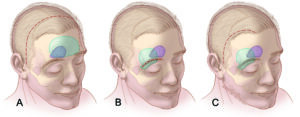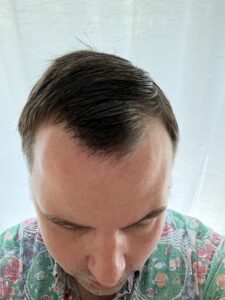After multiple opinions, Asa chose to come to UNC Health to see cerebrovascular and skull base neurosurgeon Dr. Carlos David for his brain tumor surgery.
Asa struggled with cervical spine issues from playing high school football. He started seeing an orthopedic surgeon, and discovered after imaging that he had a meningioma, a benign brain tumor, that needed to be removed.
Asa initially went to a different neurosurgeon for further imaging, which confirmed the presence of the tumor. His neurosurgeon then developed a surgical plan that involved making an incision from ear to ear to remove the tumor. This surgical technique is known as a craniotomy. “I felt good about the doctor,” recalled Asa who then spent hours watching YouTube videos about this type of surgery.
After his initial consultation, a friend of the family referred Asa to another neurosurgeon for a second opinion. This neurosurgeon concurred that the tumor needed to be removed, but recommended a minimally invasive surgical approach going through the eyebrow. The two very different surgical recommendations left Asa feeling confused as to which surgical approach would be best. “I wasn’t sure how to decide between the two recommendations,” said Asa.

Asa decided to pursue a third opinion, and scheduled a consultation with cerebrovascular and skull base neurosurgeon, Dr. Carlos David. “I wanted to see which one he agreed with,” said Asa. After consulting with Dr. David, he proposed a third way of surgery, a hybrid of the two surgical approaches presented by the previous neurosurgeons. Dr. David validated both of the recommendations and took time to explain to Asa the different approaches, why they were recommended, and then proceeded to walk him through his recommendations. He also explained to Asa that his surgical plan would improve safety and was cosmetically preferable to the two other options.
“He is a very clear communicator and took time to listen and then answer any questions that I had. His answers gave me confidence.”
Ultimately, Asa decided to have his tumor removed by Dr. David. “The thing I liked about Dr. David and what sold me on him was that he listened to me,” said Asa. “I trusted him because of his level of analysis and his willingness to explain things to me. The way that Dr. David walked me through his thinking and his colleagues’ thinking and the pros and cons, made me a lot more comfortable.”
Within a month of his consultation, Asa arrived at UNC Health in Chapel Hill to have his tumor removed by Dr. David. “I felt strangely confident,” said Asa. The tumor was removed successfully and Asa’s recovery went smoothly. “Dr. David, the nursing staff, and the resident were all very attentive,” said Asa. “After I got out of the ICU, I was walking all over the hospital and talking.”
By the time Asa was discharged from the hospital, he was feeling pretty good. “I felt fully recovered when the staples were taken out,” said Asa. “Everyone I’ve seen says that I am so far ahead of the curve.”
After surgery, Asa experienced a sensitivity to background noises that went away after two weeks of occupational therapy at UNC Health. “I told everyone that my shoulder surgery was worse than brain surgery,” said Asa.

Asa was also very impressed with the small size of his surgical scar. “My barber said that my surgeon must have known what he was doing because of how small the scar is on my head,” said Asa.
Now, three months later, Asa is doing well and recently started a new job and a regular exercise routine. “I’ve started doing body weights and dumbbell weight exercises and I walk 2-3 miles a day,” said Asa. “I just started a new job, which is a full dose of cognitive exercise.”
Asa feels grateful that he ended up at UNC Health for his brain tumor surgery. “I always felt that I was in good hands with Dr. David,” said Asa. “He is a very clear communicator and took time to listen and then answer any questions that I had. His answers gave me confidence.”
Written by: Makenzie Hardy, Marketing Coordinator, UNC Health Department of Neurosurgery